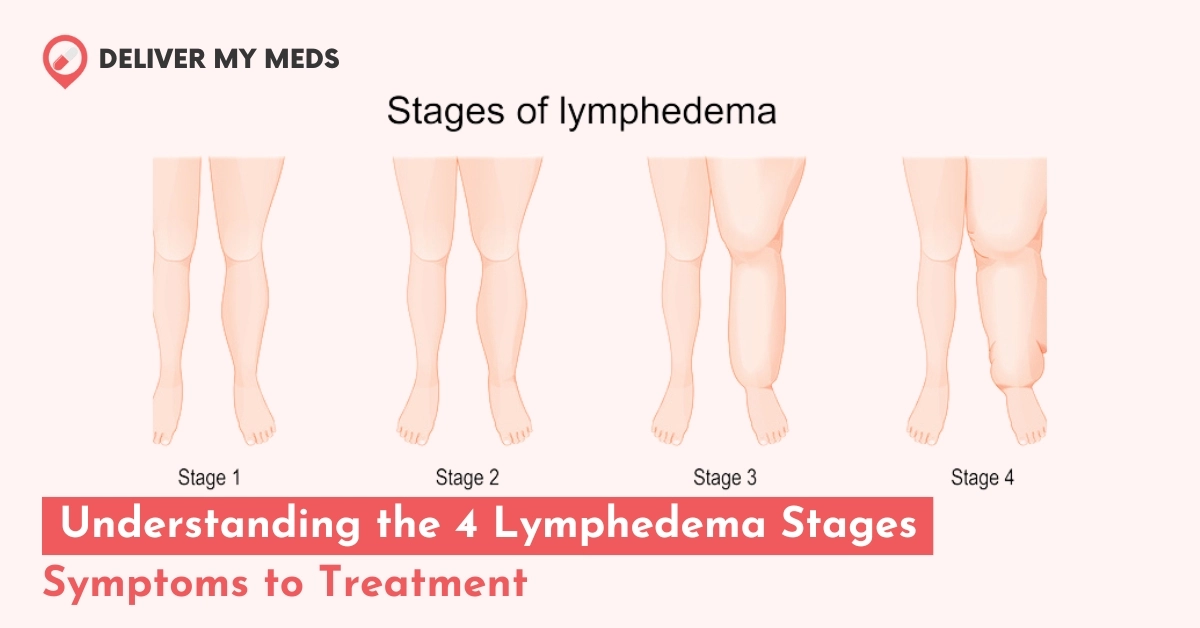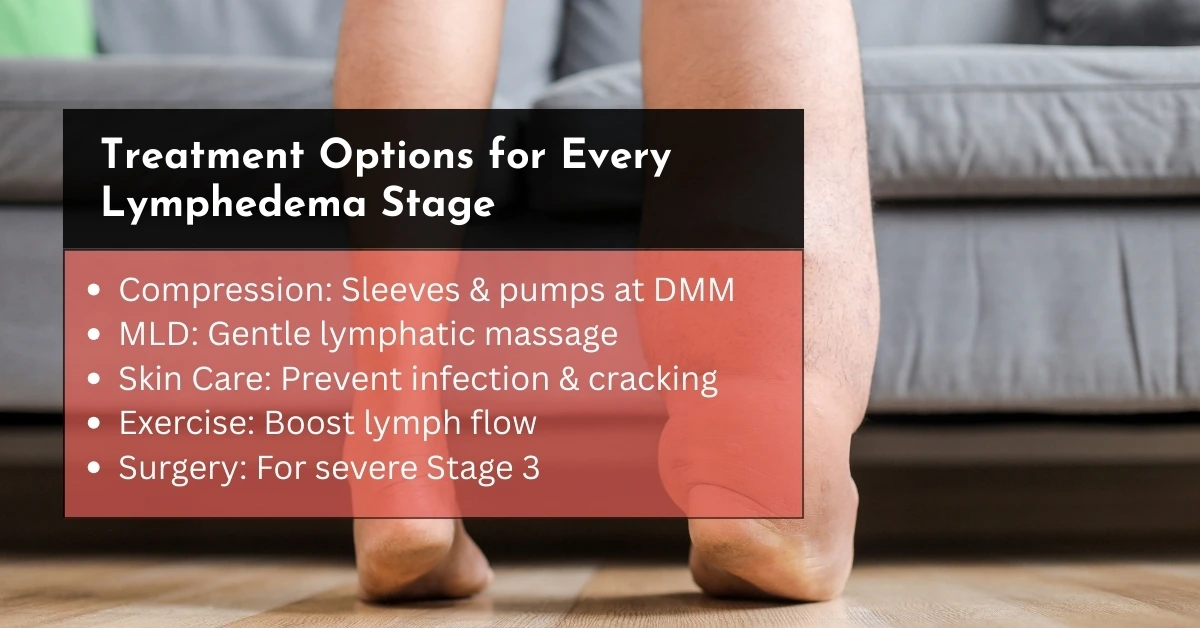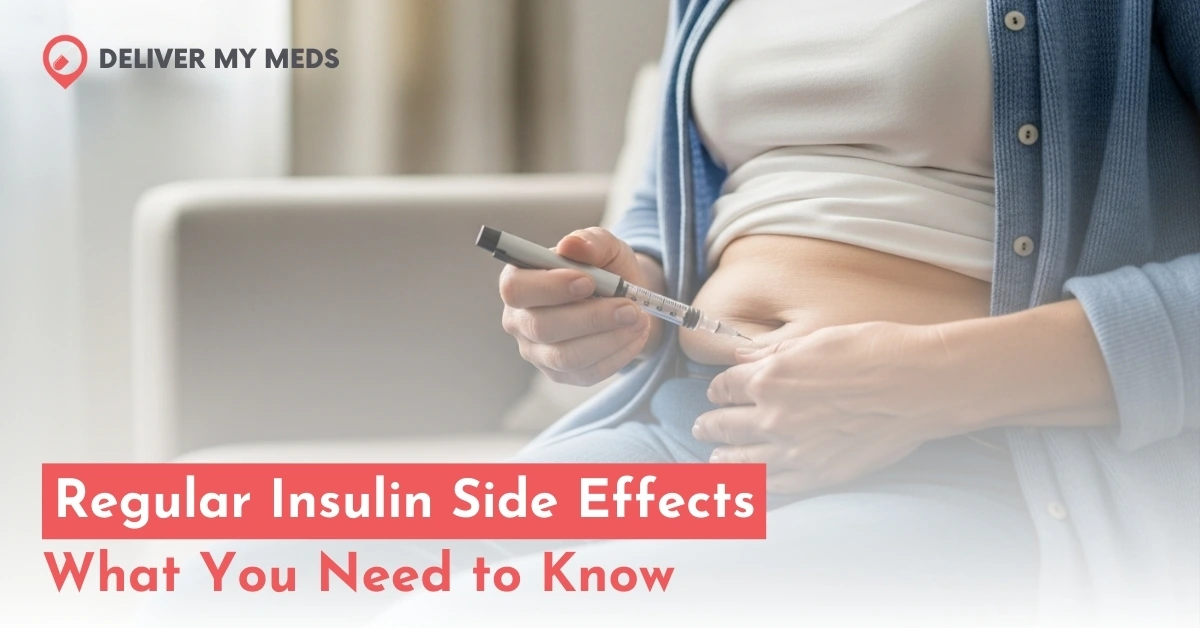
Lymphedema is a long-term condition that doesn’t start as severe but can get to irreversible stages. Lymphedema happens when fluid in the lymphatic system isn’t circulating properly, and it shows up as swelling in the arms, legs, or abdomen. The causes may include restricted blood flow following surgery, cancer treatment, or other underlying health conditions.
Treating lymphedema in the early stages is important as it progresses through different stages, from Stage 0 to Stage 3, a total of 4 stages. In this blog, we’ll give you complete information on what each lymphedema stage looks like, how it can affect different parts of your body, and the treatment options. Catching signs early matters because once the swelling sticks around, reversing it gets harder.
At Deliver My Meds (DMM), we support patients with Bio Compression Devices, insurance-covered compression pumps, for the treatment of lymphedema.
What Is Lymphedema?
Lymphedema happens when the lymphatic system gets damaged or blocked, making it hard for fluid to drain properly. It means that the natural lymph fluid flow gets restricted and starts to build up in the body’s soft tissues. The buildup shows up externally, as noticeable swelling in areas like your arms, legs, or even your abdomen. It’s long-lasting conditions that need urgent medical treatment.
There are two main types:
- Primary lymphedema: This type is uncommon in people and often linked to inherited problems in the lymphatic system. It may be present from birth or develop later in life without a known cause, just like Meige lymphedema, Milroy disease, Hennekam syndrome, and lymphedema tarda.
- Secondary lymphedema: This one’s more common and usually happens after cancer treatment, surgery (like a mastectomy), physical trauma, or due to health conditions like obesity.
It can affect your:
- Arms (common post-breast cancer)
- Legs (especially in venous insufficiency)
- Abdomen (seen in post-gynecologic surgeries or in patients with lymphedema or obesity)
How Many Stages of Lymphedema Are There?
There are 4 stages of lymphedema, from a hidden phase to severe, chronic swelling. These lymphedema stages guide diagnosis, monitoring, and treatment.
| Stage | Symptoms | Reversibility | Tissue Damage |
| 0 | No visible swelling | Yes | None |
| 1 | Pitting edema | Yes | No fibrosis |
| 2 | Firm, non-pitting edema | Partial | Beginning fibrosis |
| 3 | Thickened, hardened skin | No | Advanced fibrosis |
Lymphedema progresses through these four stages, with swelling and complications worsening over time. It can also affect life expectancy—if you want to know more, read on.
Stage 0 Lymphedema: The Genesis Phase
Also termed the latent phase, lymphedema stage 0 lacks visual manifestations but is accompanied by a breakdown of lymphatic function. The patient may experience a tightness or heaviness in the limb, particularly following surgery or radiation.
It is often overlooked, particularly in arm lymphedema following breast cancer therapy. Early changes are detectable by diagnostic imaging such as lymphoscintigraphy.
Stage 1 Lymphedema: Early, Reversible Swelling
In stage one lymphedema, soft pitting edema develops. This swelling is often mild and may resolve overnight or with limb elevation. No permanent tissue damage is present yet.
Common symptoms:
- Swelling in the hand, forearm, or lower leg
- Skin indentations after pressure
- Symptoms improve in the morning
Example: A woman with arm stage 1 lymphedema may notice mild puffiness post-surgery that improves with rest. Early compression therapy using BioCompression Arm Sleeves (8 chamber) from DMM is crucial to halt progression.
Stage 2 Lymphedema: Fibrotic Tissue Begins
By stage 2 lymphedema, swelling becomes more persistent. It no longer improves with elevation. Non-pitting edema develops due to fibrosis, a hardening of the tissue.
Changes in the skin’s texture may also appear:
- Skin becomes firm, thick, and shiny
- Hyperkeratosis (scaly patches)
- Discomfort or heaviness increases
Affected areas include:
- Lymphedema in arm (after lymph node dissection)
- Lymphedema in legs (seen with chronic venous issues)
Management includes professional pneumatic compression therapy, skin care, and medical supervision.
Stage 3 Lymphedema: Severe, Chronic Edema
Also called lymphostatic elephantiasis, stage 3 lymphedema is characterized by irreversible swelling, fat accumulation, and thickened, leathery skin.
Common in:
- Stage 3 edema in leg folds, ulcers, and mobility impairment
- Abdominal lymphedema in morbidly obese patients
- Recurrent skin infections such as cellulitis
Symptoms:
- Warty overgrowths or papillomatosis
- Limb deformity
- Functional limitations
Daily compression, wound care, and long-term support become mandatory. Deliver my meds provides advanced devices like SC-2004-DL and SC-4008-DL to assist at this stage.
Comparing Lymphedema in Arms, Legs & Abdomen
Progression may vary based on the affected region. Below is a table comparing signs of lymphedema by area:
| Stage | Arm Lymphedema | Leg Lymphedema | Abdominal Lymphedema |
| 0 | No swelling, post-op | No swelling, heaviness | Hidden swelling post-surgery |
| 1 | Pitting, soft | Morning relief | Mild bloating or fullness |
| 2 | Hardening, fibrosis | Skin texture changes | Persistent swelling |
| 3 | Severe thickening | Ulcer risk, skin folds | Obesity-linked inflammation |
Obesity and Its Impact on Lymphedema Stages
Lymphedema obesity is a major risk factor for faster disease progression.
Why?
- Adipose tissue causes inflammation and impairs lymphatic drainage
- Fat deposits increase fluid retention
- Infection risk rises
Management:
- Weight control
- Compression therapy (daily use)
Treatment Options for Every Lymphedema Stage
Lymphedema is manageable at every stage with:
- Manual lymphatic drainage (MLD): Specialized massage
- Compression sleeves & pumps: Available at DMM
- Skin care: Prevent infection and cracking
- Movement & exercise: Promotes lymph flow
- Surgery: For severe or nonresponsive stage 3 lymphedema
Conclusion
Staging is the cornerstone of lymphedema management. Detection of symptoms and treatment needs from stage 0 to stage 3 lymphedema can prevent progression and maintain quality of life. Deliver my meds, always care for the people if they have diabetes or lymphedema-like diseases. It also assists patients all along the way with CGm and Bio Compression Devices, insurance assistance, and monthly refill services. If you are experiencing symptoms of swelling or heaviness, we recommend that you visit your doctor or contact DMM regarding your compression pump.




